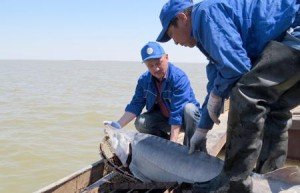 ATYRAU – Five Caspian states are united by a common goal – to preserve biological diversity of the Caspian Sea. The danger of the extinction of sturgeon is such a special problem a moratorium on their catch was imposed a few years ago at the initiative of Kazakh President Nursultan Nazarbayev.
ATYRAU – Five Caspian states are united by a common goal – to preserve biological diversity of the Caspian Sea. The danger of the extinction of sturgeon is such a special problem a moratorium on their catch was imposed a few years ago at the initiative of Kazakh President Nursultan Nazarbayev.
Like other Caspian countries, Kazakhstan has undertaken a commitment to reproduce the sturgeon population. Because the northern Caspian is a favourite feeding ground for sturgeon, the state budget annually allocates funds to two Atyrau hatcheries for the breeding of seven million sturgeon fingerlings. Usually, adults which come to spawn in the Ural River are “milked” at the factories and then released to the sea with the words “come back again.”
This time, the first “milked” fish were delivered to the “pasture” in special bowls and in the presence of a commission, which included representatives of fishery inspection. Three belugas, four sturgeons and 58 starred sturgeons were released to their native home – the sea.
Coupled with the moratorium on fishing and the anti-poaching operation Bekіre, the old timers hope the former glory of the Atyrau region, which once produced caviar and tonnes of delicacy sturgeon, will be revived in the coming years. They still remember the spring fishing season of 1977 when the plant Atyraubalyk produced 12,000 tonnes of sturgeon and 1,250 tonnes of black caviar. Since then, as they say “much water has flowed” and last year the plant went to the bottom, quietly going bankrupt.
Bostan Suleimenov, chief specialist of the department of ichthyological monitoring and regulation of fishing of the Zhaiyk interregional fishery inspection, said that the measures currently being taken, however, allow them only to save beluga and sturgeon from extinction. He is convinced the moratorium on commercial production should operate for at least 20 years.
According to Suleimenov, it is necessary to reconstruct fish farms. The modernisation and construction of special wintering ponds will allow the hatching of a brood stock.
“Over the past three decades, the sturgeon population was reduced by 70-80 percent and the question of reconstruction is relevant as never before,” added director of the Atyrau sturgeon hatchery Rashid Kalidullin. “After the upgrade, each of the two plants will produce seven million sturgeon fingerlings. In addition, we will form a breeding stock and develop commodity production of sturgeon. The latter will be an effective measure against poaching.”
“We should not forget that major state funds are spent on permanently fighting the poaching and enormous resources of law enforcement agencies, including the army and border guards, are engaged in it. Meanwhile, those who are directly involved in the conservation of fish get modest salaries and we hope that maybe this year the situation will begin to change” he said.


